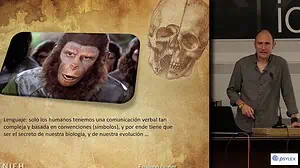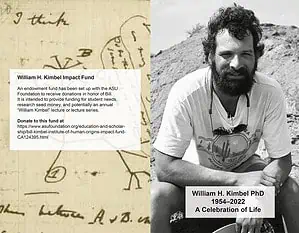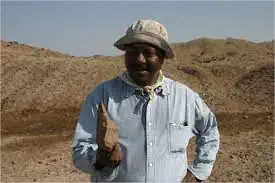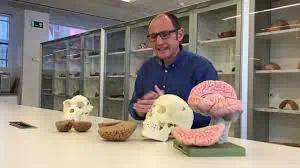Emiliano Bruner team’s re-examines Gana skull from Ethiopia which show early Homo or late Australopithecus
 Emiliano Bruno of the Centro Nacional de Investigación sobre la Evolución Humana (CENIEH), together with his colleague archaeologist Sileshi Semaw and their research assistants, may have just solved a mystery that has been plaguing the paleo-anthropology community for decades: Where and when did genus Homo begin.
Emiliano Bruno of the Centro Nacional de Investigación sobre la Evolución Humana (CENIEH), together with his colleague archaeologist Sileshi Semaw and their research assistants, may have just solved a mystery that has been plaguing the paleo-anthropology community for decades: Where and when did genus Homo begin.
From his bio:
Emiliano Bruner has a university degree in Biology, and a PhD in Animal Biology (University La Sapienza, Roma, Italy). Since 2007 he is researcher in Hominid Paleoneurobiology at the National Research Center for Human Evolution in Burgos (Spain). After a career in zoology and ecology, he worked with primates and museum collections and, subsequently, in human ecology and paleoanthropology. He mainly works in anatomy and morphology of skull, brain and vessels, in modern human populations, extinct hominids, and other living primates. He employs tools from digital anatomy and spatial modeling in evolutionary neuroanatomy and functional craniology. He also works in cognitive archaeology, in particular in the evolution of the parietal cortex and its visuospatial functions.
Australopiths to Homo habilis to Homo ergaster? Or, a new timeline
William Kimbel, a Evo Science professor of ASU was a Donald Johanson team member at the Afar in Ethiopia when Lucy was discovered: From a CARTA lecture on YouTube, 2017, “Australopithecus and the Emergence of Earliest Homo”:
 To illustrate what in my view is where the genus Homo arose… the modern history of the discovery of the genus Homo really begins with Louis Leakey and his colleagues, and the recognition of the species Homo habilis in 1964… they discerned in the type of the species, an increase in dexterity in the hand.
To illustrate what in my view is where the genus Homo arose… the modern history of the discovery of the genus Homo really begins with Louis Leakey and his colleagues, and the recognition of the species Homo habilis in 1964… they discerned in the type of the species, an increase in dexterity in the hand.
They discerned a noticeable increase in the endocranial volume, brain size in relation to then know, Australopithecus species… and a reduction in tooth size… [with the discovery of tools]… they arrived at the conclusion that this species belonged at the base of the genus Homo.
At 9 minutes in the lecture, Prof. Kimbell identifies Homo ergaster (early Erectus) as one of the four contenders for the first member of the genus Homo. He goes on to suggest that climate change in and around 2.6 to 2.8 million years ago, led to a drying in northern Africa and a more grassland environment, which may have led to the emergence of the genus Homo. He also cites newer evidence suggesting stone tool usage began earlier than previously believed, perhaps as far back as 3.6 million years ago.
(Note – Sadly Bill Kimbel passed away last summer after a long battle with cancer.)
In 2018, another fossil was found in Ethiopia, a 1.5 million-year-old cranium DAN5/P1. Details of the discovery, from the Leakey Foundation:
 An international research team led by scientists from the U.S. and Spain, supported in part by The Leakey Foundation, has discovered a nearly complete cranium of an early human ancestor, estimated to about 1.5 million years ago, and a partial cranium dated to about 1.26 million years ago, from the Gona study area in Ethiopia’s Afar State.
An international research team led by scientists from the U.S. and Spain, supported in part by The Leakey Foundation, has discovered a nearly complete cranium of an early human ancestor, estimated to about 1.5 million years ago, and a partial cranium dated to about 1.26 million years ago, from the Gona study area in Ethiopia’s Afar State.
The team was led by Leakey Foundation grantees Sileshi Semaw of the Centro Nacional de Investigación sobre la Evolución Humana (CENIEH) in Spain…
Gona is located in the Afar Triangle of Ethiopia, adjacent to the well-known Middle Awash and Hadar study areas, where the famous skeletons “Ardi” and “Lucy” were found, respectively.
Interestingly, the skull was discovered by a local Afar teenage boy Ibrahim Habib. (Photo of Ibrahim at the Leakey Foundation article).
Now a paper has been published. From Wiley Online Library, March 3,
The endocast from Dana Aoule North (DAN5/P1): A 1.5 million year-old human braincase from Gona, Afar, Ethiopia
 The nearly complete cranium DAN5/P1 was found at Gona (Afar, Ethiopia), dated to 1.5–1.6 Ma, and assigned to the species Homo erectus. Its size is, nonetheless, particularly small for the known range of variation of this taxon, and the cranial capacity has been estimated as 598 cc.
The nearly complete cranium DAN5/P1 was found at Gona (Afar, Ethiopia), dated to 1.5–1.6 Ma, and assigned to the species Homo erectus. Its size is, nonetheless, particularly small for the known range of variation of this taxon, and the cranial capacity has been estimated as 598 cc.
Bruno and the paper’s other authors then make a startling admission. The Gona cranium suggests a halfway species between Homo habilis and Australopithecus. (endocranial = brain size):
Based on our set of [endocranial] measures, the general endocranial proportions are within the range of fossils included in the species Homo habilis or in the genus Australopithecus.
They add:
This new specimen extends the known brain size variability of Homo ergaster/erectus, while suggesting that differences in gross brain proportions among early human species, or even between early humans and australopiths, were absent or subtle.
Proportions of the Gona cranium “are similar to those of the australopiths”
Despite tantalizing clues, Bruner and colleagues do not answer definitely if Homo ergaster is an Australopith. They suggest that positioning of Homo ergaster and Homo habilis in the middle Pleistocene is still to be determined.
More from Phys.org, March 3,
Team publishes study of the brain of the Homo erectus fossil with the lowest cranial capacity
DAN5/P1, found at the Gona site in Ethiopia, whose cranial morphology indicates that it belongs to the species Homo erectus, and in particular, to its earliest African stage, where it is sometimes identified using the name H. ergaster.
The results of the study of this fossil, which is very small for these hominin groups, suggest that its cerebral morphology does not present any traits distinctive to the human genus: Its proportions are similar to those of australopiths, or species whose evolutionary position and whether they are from our own lineage remains to be determined, as is the case with H. habilis
Video on Homo habilis and Homo ergaster in Spanish with English substitles at Fundación Palarq. (Cover photo). Photo h/t for Professor William Kimbel, Celebration of Life fund, to the Institute for Human Origins at ASU.
In my opinion, what is needed is a whole new timeline, for the Human family line, as so far, applying the term Homo, to a bunch of ape like Australopithicus, is incredibly wrong.
What separates Humans from the apes, is intelligence, and those small brains in early ape like fossils, just doesn’t fill the bill for Human ancestors.
I remember a theory that Humans developed from apelike ancestors, because some of the young specimens, never grew up, they never grew into adult apes, but kept their flatter young faces, and didn’t develop the prognathous face of the adult ape, at the same time their brains continued growing, in stead of stopping growth at a young age as in apes.
This theory was shot down by geneticists as that would be a mutation, and genetically that happens to individuals, or within families, but not across a whole species at once, genetically that can’t happen.
The thing is mutation aren’t only caused by gene function, or misfunction, genes can be changed by outside environmental sources, radiation in particular, as in billions of years ago a star blew up sending out a massive blast of cosmic rays in all directions, and a million or two years ago, what was left of that blast, showed up in our star system, and traveling at the speed of light, passed over Earth, hitting mostly one side of the Earth, (the Northern Hemisphere perhaps?) and quickly
gave every living thing on that side of Earth a big dose of cosmic rays that shut down some genes, those that would turn off young ape like Human ancestors genes, such as those genes that would turn it into an adult ape, and left other genes to continue growing, such as for the brain, there by growing into a larger adolescent version of the ape family it came from, and a much smarter ape too.
The cosmic ray blast would have been brief, but it would have changed other animals as well, and it could have been associated with one of the many die off events that Earth has experienced, so it may be possible to pinpoint a particular time frame for when this occurred and Humanity truly began.
The Gona cranium we’re talking about here is known as DAN5.
Emiliano Bruner says DAN5 has “general endocranial proportions within the range of fossils included in the species Homo habilis or in the genus Australopithecus.”
The Leakey Foundation says DAN5 is “the smallest Homo erectus cranium in Africa.”
How does any of this “solve the mystery of where and when did genus Homo begin?”
I agree with you, Erik, that “applying the term Homo to a bunch of apes like australopithecus is incredibly wrong.” That seems especially true considering recent findings that non-hominin primates can and do produce some Oldowan tools.
Evidence that cosmic rays have produced quantum leaps in human genetic change is so far limited to the Fantastic Four.
In the lab, radiation, can produce mutations in mice and rats and flies.
Mutations don’t have to be a negative thing, positive mutations can happen over time in the real world.
So hypothesizing a large part of Earth, involved event, of rather brief radiation time, that did produce what was ultimately positive mutations in certain apes at certain ages, isn’t SF, and it would no doubt have effected other species, and it could be recognized as having happened, at a time of an extinction event on Earth, and we could then give a time for the start of the true Human Race.
Real Humans have higher intellect, and it seems that that change, the development of the Neocortex and the Frontal lobe, couldn’t happen to just one individual and he passed it down genetically from there, the likely hood of that genetic change surviving, would be very small at best, yet a possible genetic changing, large scale event, at one time, would surely made the genetic change to many at once, very survivable.
Erik, I don’t dismiss that mutations, radiation, and cosmic events can impact the evolution of life.
My issue is with speculatively assigning species-changing cause and effect with no empirical evidence whatsoever.
The evidence I personally find compelling:
The record shows that hominin evolution occurred incrementally with stops and starts over long spans of time over great migratory distances throughout highly-varied environments with much genetic ebb and flow.
Virtually all genetic mutations are filtered out immediately — negatively selected for both the individual and the species. The rare rare few mutations that survive are usually innocuous, minute, and self-limiting; they provide no selective benefit in and of themselves and are only impactful when combined with others in a unique, unprecedented way. One small change can make other small changes in the future possible and the cumulative effects can eventually become meaningful.
In my opinion, the notion that the essence of humanity could be the product of large-scale genetic-changing mega-events is simplistic and just too damned easy to be true.
This article cites the late William Kimbel concluding that DAN5’s “species belonged at the base of the genus Homo” because the cranium was small and shape not completely archetypical of Homo erectus, teeth were smallish, and dating about 1.5 mya.
This conclusion is Kimbel’s 2017 surmise, his speculation, his interpretation for which there is no corroborating evidence. Maybe he’s right, but there are other explanations.
The Leakey Foundation cited in this article comes to a different conclusion. Nearby the DAN5 specimen they found specimen BSN12:
“The BSN12 partial cranium is robust and large, while the DAN5 cranium is smaller and more gracile, suggesting that Homo erectus was probably a sexually dimorphic species. Remarkably, the DAN5 cranium has the smallest endocranial volume documented for Homo erectus in Africa, about 590 cubic centimeters, probably representing a female.”
Now, the sexual dimorphism of hominins is a well-documented fact. So for me, this explanation seems more likely than the guess that DAN5 could be some kind of unprecedented transitional early Homo pioneer.
Further, my sense of the broader hominin record is that if you ever were to come across the kind of early Homo critter that Kimbel speculates, you would expect it to be older than 1.5 million years.
Too simple and easy?
Isn’t that how the law of parsimony, Occam’s Razor, describes how to get the right answer scientifically?
It’s not only strange that intelligence emerged at all, but that it also emerged, all through Eurasia, at the same time, and this higher intelligence didn’t happen in sub-Saharan Africa at all, leading to the “simple” conclusion that some large event happened to a significant number of the ape population of Eurasia, that triggered the growth of the Human Brain.
If, Larger brains happened in only one place on Earth, then it would be reasonable to assume, that those Humans would’ve been the most successful, and only Human population, however the fact that the Human brain grew from different groups of apes, in different geographical locations, again at about the same time in prehistory means that some common event, triggered that occurrence, and a massive burst of radiation from space, is the only thing I can think of that fills the bill for that event.
1. “The law of Parsimony, Occam’s Razor…to get the right answer scientifically.”
AKA “the simplest answer is more likely correct.” This is abductive reasoning, logical fallacy, and anti-science. You misunderstand the full depth of the concept, do more research.
I say Joe Biden’s policies are poor because he’s morally depraved, financially corrupt, and mentally disabled.
You say Joe Biden’s policies are poor because he’s a donut.
Your explanation is the simplest so it must be correct, yes?
2. “intelligence emerged…all through Eurasia at the same time”
No it didn’t. There’s nothing to support that claim, in fact the record says exactly the opposite. Where are you getting this?
3. “higher intelligence didn’t happen in sub-Saharan Africa at all”
Yes it did.
4. “…leading to the “simple” conclusion that some large event happened to a significant number of the ape population of Eurasia”
Your premises are invalid so the conclusion cannot derive logically from them.
5. “If, Larger brains happened in only one place on Earth…”
They did not. But if you think you have contrary information I’m listening.
6. “the fact that the Human brain grew from different groups of apes, in different geographical locations, again at about the same time in prehistory means that some common event, triggered that occurrence….”
First you say it only happened in Eurasia, then you say it happened in different geographical locations. I am genuinely confused.
So you’re saying that cosmic rays selectively rained down on Eurasia, stopped when it came to Africa? That’s why Eurasians are smart and Africans are dumb? Is this your thesis?
*crickets*
I may be old school, but if someone publicly posts something they should at least have the sand to defend what they said and why. Drive-by accusations are not discussion.
Bretcarr2001 on Youtube already broke down the genetic engineering that took place and explained how the dates and order of these hominoids are out of order by the so called “scientists” in his 9 part series “From Gods To Apes: Reverse Engineering The Caucasian Race.” In part 3 is where he begins to break down the science, starting with the “Adam & Eve” of ManKind – The Pygmies and Austrailian Aboriginals. Sensitive Topic for some but I’m still waiting for someone to prove it wrong. BTW – Check out my store @ http://www.cedargroveherbs.com
There is such a thing as too much opium.